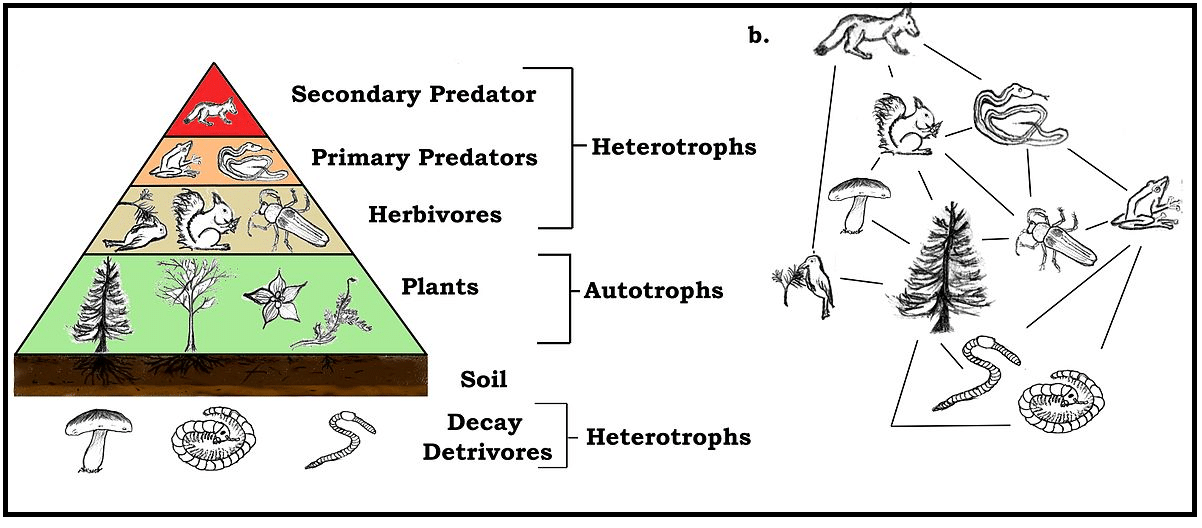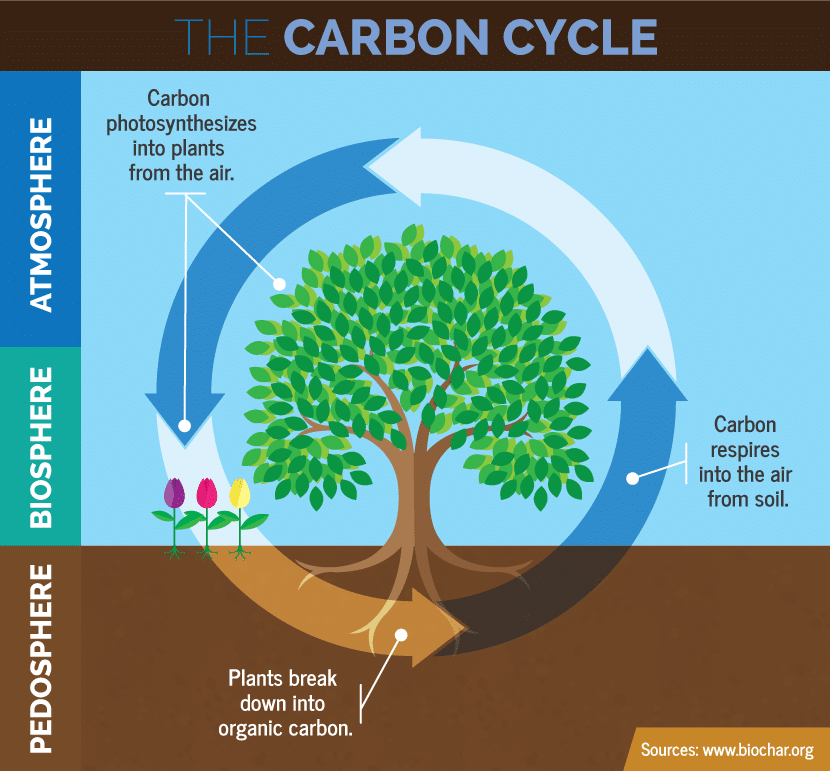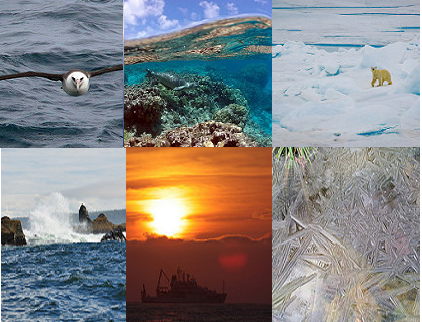Life Sciences – Interdependence of Organisms
Grade 8 Science Worksheets
Our Environment
All that is around us is our Environment. Humans, animals, plants, fish, every living organism has an environment. Life science proves that the environment of an organism both sustains and affects it. Living environmental factors are called Biotic and nonliving are called Abiotic environments. Both are essential for an organism.
Weather, for example, is an Abiotic Environment. All living beings must learn to adapt to weather conditions or they could die. Other abiotic environmental factors are soil, nutrients, water, atmosphere, temperature, sunlight, and so on.
Our Biotic Environment is made up of living and recently living matter such as food, plants, animals, seaweed, even the bacteria in our intestines which help the digestion process.
Our Ecosystems
Biotic and Abiotic environments together make up our Ecosystem. An ecosystem therefore consists of plants, animals, other living organisms, which depend on and interact with one another for their sustenance and survival in a given set of nonliving factors and conditions. This all together constitutes the Interdependence of Species.
Our primary ecosystem works as follows –
- The Sun provides energy.
- Plants use this energy and also nutrients (abiotic factors) to make food by the process of
- Many animals live and grow by eating these plants as food.
- Many animals eat other animals to live and grow.
- Other creatures eat the remains of these animals.
- Bacteria and fungi decompose dead plants and animals to form nutrients.
- Nutrients go back into the soil to provide plants with an abiotic environment.
The plants are thus the primary producers, the animals which eat only plants are the primary consumers, animals which eat these animals are the secondary consumers, animals that eat the remains of dead animals are termed tertiary consumers, and the organisms which act on decaying matter are the decomposers.

This transformation of energy into food constitutes a food chain whereby many living organisms or species within a given ecosystem can sustain themselves. Food chains exist even in the deepest of oceans where microbes get nutrients from below the earth’s crust and produce food for other marine creatures.
Many overlapping food chains make a food web, which is an interconnection of food producers, consumers and decomposers from multiple food chains. Complex food webs exist in the oceans and tropical regions of earth.
Organisms that produce their own food, such as algae, seaweed, wheat and grass are often at the lowest end of any food chain. Such organisms are referred to as Autotrophs. These are the primary producers in any ecosystem.
Organisms which cannot produce their own food and need to depend on other plants and animals for their sources of food are termed as Heterotrophs. All secondary and tertiary consumers are therefore heterotrophs.
Learn more about Life Sciences and other important topics with 8th Grade Science Tutoring at eTutorWorld. Our expert science tutors break down the topics through interactive one-to-one sessions. We also offer the advantage of customized lesson plans, flexible schedules and convenience of learning from home.
eTutorWorld Understands Math Tutoring | Online Math Worksheets are Important Tools
Understanding graphs, charts, and opinion polls in a newspaper, for calculating house and car payments, and for choosing a long-distance telephone service are impossible without strong math skills …and the only way to develop strong math skills is by constant practice.
‘Practice makes a man perfect’ holds true for no other field better than for math. A middle or high school student must set aside a minimum of an hour for math every day. Other than textbooks, worksheets help you revise and understand concepts better.
Our expert tutors prepare online maths worksheets that are age and grade-appropriate. Grade-wise math worksheets for Elementary Math, Arithmetic, Pre-Algebra, Algebra, Geometry, Trigonometry, Statistics, Pre-Calculus and Calculus can be solved to improve math skills, to get ahead or to even catch up.
You may download these FREE online math worksheets in the PDF format, and then print and email us their solutions for a free evaluation and analysis by eTutorworld’smath expert tutors.
You may solve these worksheets by yourself or with your peers while studying together.
The Answer Key at the end of each worksheet allows for a self-evaluation.
Personalized Online Tutoring
eTutorWorld offers affordable one-on-one live tutoring over the web for Grades K-12, Test Prep help for Standardized tests like SCAT, CogAT, MAP, SSAT, SAT, ACT, ISEE and AP. You may schedule online tutoring lessons at your personal scheduled times, all with a Money-Back Guarantee. The first one-on-one online tutoring lesson is always FREE, no purchase obligation, no credit card required.
For answers/solutions to any question or to learn concepts, take a FREE CLASS.
No credit card required, no obligation to purchase.
Just book a free class to meet a tutor and get help on any topic you want!

Nature Cycles
An ecosystem sustains itself through many Nature Cycles. The Carbon Cycle for example works as follows –
- Animals survive by breathing in oxygen and breathing out carbon dioxide
- Humans burn fossil fuels which also releases carbon dioxide in the atmosphere
- Plants absorb carbon dioxide and release oxygen which sustains animals
Other major cycles in nature include the Water cycle and Nitrogen cycle. These cycles maintain balance in the ecosystem and ensure abundance of energy, food and water in any environment.
Our Habitats
Plants and animals live in a particular place depending on their basic needs to live. These particular places are termed Habitats. Cacti and scorpions, for example, live in a desert habitat. Large fish and whales live in an aquatic habitat. Mountain goats and snow leopards live in a mountainous habitat. Pine trees are found only in high altitude habitats. Lakes, seashores, rain forests, all are natural habitats. Each habitat drives its own peculiar ecosystem, food chains and food webs for the sustenance of the species found in that environment.
How many organisms of a particular species can a particular habitat support?

Carrying Capacity is a measure of population density of a species for an environment. It is an important measure of environmental sustainability. If the carrying capacity of a species in a habitat is exceeded then it may cause an imbalance in that habitat. A balance is maintained to some extent by the predators and preys in that habitat. If both predators and preys grow in population at a particular pace, the environment can be sustained for a long time. An imbalance in this growth can lead to extinction of one or both species. For example, if predators outgrow prey, they could face shortage of food and be ultimately both species would be wiped out.
A Delicate Balance
Nature is a delicate balance in any habitat. It can be upset by many factors leading to hunger, migration or extinction of species. Some prime examples of how humans can upset the ecology on a habitat are –
- Converting forests into farmlands or for industry
- Creating pollution on land, air or water
- Depleting resources such as overfishing or poaching
- Hunting endangered species leading to their extinction
Human activities such as these lead to a loss in biodiversity through the extinction of species and cause ecological imbalances on earth. As responsible citizens of planet earth we must take utmost care that we do not upset this delicate balance.

Check Point
- Soil, nutrients, water, atmosphere, temperature, sunlight are all examples of _______ environment.
- The process by which plants convert energy to food is termed _______.
- Organisms that can produce their own food are called ______ while those that cannot are called ______.
- Name three important cycles in nature.
- ______ is a measure of how much population of a species can be carried by a habitat.
Answer Key
- Abiotic
- Photosynthesis
- Autotrophs, Heterotrophs
- Carbon cycle, Nitrogen cycle, Water cycle
- Carrying Capacity
Learn more about Life Sciences and other important topics with 8th Grade Science Tutoring at eTutorWorld. Our expert science tutors break down the topics through interactive one-to-one sessions. We also offer the advantage of customized lesson plans, flexible schedules and convenience of learning from home.
Schedule a Free session to clear worksheet doubts
No credit card required, no obligation to purchase.
Just schedule a FREE Sessions to meet a tutor and get help on any topic you want!
Pricing for Online Tutoring
| Tutoring Package | Validity | Grade (1-12), College |
|---|---|---|
| 5 sessions | 1 Month | $139 |
| 1 session | 1 Month | $28 |
| 10 sessions | 3 months | $269 |
| 15 sessions | 3 months | $399 |
| 20 sessions | 4 months | $499 |
| 50 sessions | 6 months | $1189 |
| 100 sessions | 12 months | $2249 |
8th Grade Free Worksheets
- The Universe
- Heredity
- Evolutionary Theory
- Structure of the atom
- Ethical Practices
- Unveiling the mystery behind the physical universe
- Components of the universe
- Celestial phenomena
- The tilt of Earth’s axis
- The causes of high and low tides
- Earth Systems
- Rocks and Fossils
- Weather and Climate
- Basics of chemical reactions
- Types of Chemical reactions – Endothermic, exothermic, oxidation, reduction reactions
- Catalysts and enzymes
- Compounds and mixtures
- Acids, Bases and pH Indicators
IN THE NEWS

Our mission is to provide high quality online tutoring services, using state of the art Internet technology, to school students worldwide.
Online test prep and practice
SCAT
SSAT
ISEE
PSAT
SAT
ACT
AP Exam
Science Tutoring
Physics Tutoring
Chemistry Tutoring
Biology Tutoring
Math Tutoring
Pre-Algebra Tutoring
Algebra Tutoring
Pre Calculus Tutoring
Calculus Tutoring
Geometry Tutoring
Trigonometry Tutoring
Statistics Tutoring
Quick links
Free Worksheets
Fact sheet
Sales Partner Opportunities
Parents
Passive Fundraising
Virtual Fundraising
Our Expert Tutors
Safe and Secure Tutoring
Interactive Online Tutoring
After School Tutoring
Elementary School Tutoring
Middle School Tutoring
High School Tutoring
Home Work Help
Math Tutors New York City
Press
©2022 eTutorWorld Terms of use Privacy Policy Site by Little Red Bird
©2022 eTutorWorld
Terms of use
Privacy Policy
Site by Little Red Bird






